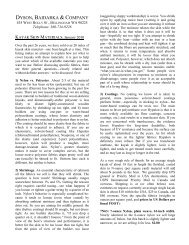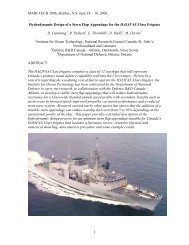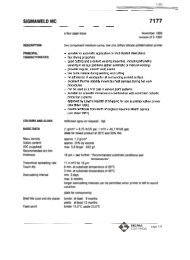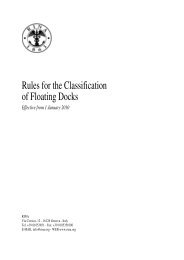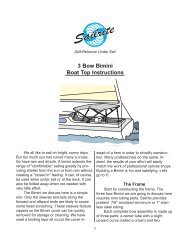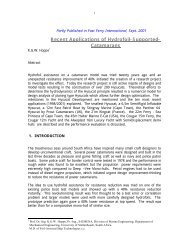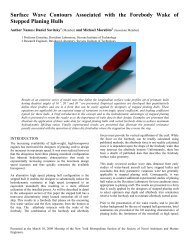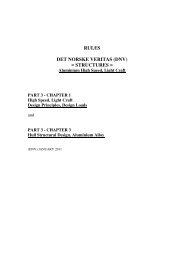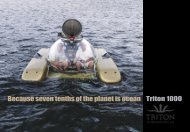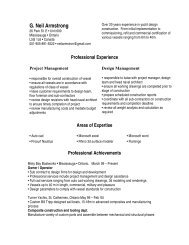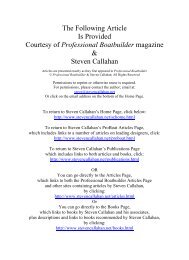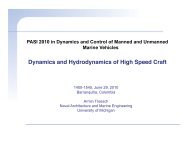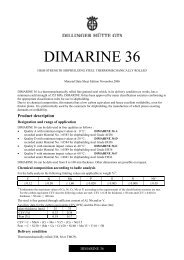Pt C, Ch 1, Sec 12.6 Power of machinery2.6.1 Unless otherwise stated in each Section of this Chapter,where scantlings of components are based on power,the values to be used are determined as follows:• for main propulsion machinery, the power/rotationalspeed for which classification is requested• for auxiliary machinery, the power/rotational speedwhich is available in service.2.7 Astern power2.7.1 Where power exceeds 5 kW, means for going asternis to be provided to secure proper control of the yacht in allnormal circumstances.The main propulsion machinery is to be capable of maintainingin free route astern at least 70% of the maximumahead revolutions for a period of at least 30 min.For main propulsion systems with reversing gears, controllablepitch propellers or electrical propeller drive, runningastern is not to lead to an overload of propulsion machinery.During the sea trials, the ability of the main propulsionmachinery to reverse the direction of thrust of the propelleris to be demonstrated and recorded (see also Ch 1, Sec 10).2.8 Safety devices2.8.1 Where risk from overspeeding of machinery exists,means are to be provided to ensure that the safe speed isnot exceeded.2.8.2 Where main or auxiliary machinery including pressurevessels or any parts of such machinery are subject tointernal pressure and may be subject to dangerous overpressure,means are to be provided, where practicable, to protectagainst such excessive pressure.2.8.3 Where applicable, main internal combustion propulsionmachinery and auxiliary machinery are to be providedwith automatic shut-off arrangements in the case of failures,such as lubricating oil supply failure, which could lead rapidlyto complete breakdown, serious damage or explosion.The Society may permit provisions for overriding automaticshut-off devices.See also the specific requirements given in the other Sectionsof this Chapter.2.9 Fuels2.9.1 Fuel oils employed for engines and boilers are, ingeneral, to have a flash point (determined using the closedcup test) of not less than 60°C. However, for engines drivingemergency generators, fuel oils having a flash point of lessthan 60°C but not less than 43°C are acceptable.For yachts assigned with a restricted navigation notation, orwhenever special precautions are taken to the Society’s satisfaction,fuel oils having a flash point of less than 60°C butnot less than 43°C may be used for engines and boilers,provided that, from previously effected checks, it is evidentthat the temperature of spaces where fuel oil is stored oremployed will be at least 10°C below the fuel oil flash pointat all times.Fuel oil having flash points of less than 43°C may beemployed on board provided that it is stored outsidemachinery spaces and the arrangements adopted are speciallyapproved by the Society (see also Ch 4, Sec 9).3 Arrangement and installation on board3.1 General3.1.1 Provision is to be made to facilitate cleaning, inspectionand maintenance of main propulsion and auxiliarymachinery, including boilers and pressure vessels.Easy access to the various parts of the propulsion machineryis to be provided by means of metallic ladders and gratingsfitted with strong and safe handrails.Spaces containing main and auxiliary machinery are to beprovided with adequate lighting and ventilation.3.2 Gratings3.2.1 Gratings in engine rooms, if any, are to be metallic,divided into easily removable panels.3.3 Bolting down3.3.1 Bedplates of machinery are to be securely fixed to thesupporting structures by means of foundation bolts whichare to be distributed as evenly as practicable and of a sufficientnumber and size so as to ensure proper fitting.Where the bedplates bear directly on the inner bottom plating,the bolts are to be fitted with suitable gaskets so as toensure a tight fit and are to be arranged with their headswithin the double bottom.Continuous contact between bedplates and foundationsalong the bolting line is to be achieved by means of chocksof suitable thickness, carefully arranged to ensure a completecontact.The same requirements apply to thrust block and shaft linebearing foundations.Particular care is to be taken to obtain levelling and generalalignment between the propulsion engines and their shafting(see also Ch 1, Sec 2, [7]).3.3.2 Chocking resins are to be type approved.3.3.3 Where stays are provided for fixing the upper part ofengines to the yacht’s structure in order, for example, toreduce the amplitude of engine vibrations, such stays are tobe so designed as to prevent damage to these engines furtherto deformation of the shell plating in way of the saidstays. The stays are to be connected to the hull in such away as to avoid abnormal local loads on the structure of theyacht.July 2006 with February 2008 Amendments Bureau Veritas Rules for Yachts 309
Pt C, Ch 1, Sec 13.4 Safety devices on moving parts3.4.1 Suitable protective devices on access restrictions areto be provided in way of moving parts (flywheels, couplings,etc.) in order to avoid accidental contact of personnelwith moving parts.3.5 Gauges3.5.1 All gauges are to be grouped, as far as possible, neareach manoeuvring position; in any event, they are to beclearly visible.3.6 Ventilation in engine or machineryspaces3.6.1 Engine or machinery spaces are to be sufficientlyventilated so as to ensure that when machinery or boilerstherein are operating at full power in all weather conditions,including heavy weather, a sufficient supply of air is maintainedto the spaces for the operation of the machinery.This sufficient amount of air is to be supplied through suitablyprotected openings arranged in such a way that they canbe used in all weather conditions, taking into account Regulation19 of the 1966 Load Line Convention.Special attention is to be paid both to air delivery andextraction and to air distribution in the various spaces. Thequantity and distribution of air are to be such as to satisfymachinery requirements for developing maximum continuouspower.The ventilation is to be so arranged as to prevent any accumulationof flammable gases or vapours.3.7 Hot surfaces and fire protection3.7.1 Surfaces, having temperature exceeding 60°C, withwhich the crew are likely to come into contact during operationare to be suitably protected or insulated.Surfaces of machinery with temperatures above 220°C, e.g.steam, thermal oil and exhaust gas lines, silencers, exhaustgas boilers and turbochargers, are to be effectively insulatedwith non-combustible material or equivalently protected toprevent the ignition of combustible materials coming intocontact with them. Where the insulation used for this purposeis oil absorbent or may permit the penetration of oil,the insulation is to be encased in steel sheathing or equivalentmaterial.Fire protection, detection and extinction are to comply withthe requirements of Part C, Chapter 4.3.8 Machinery remote control, alarms3.8.1 For remote control systems of main propulsionmachinery and essential auxiliary machinery and relevantalarms and safety systems, the requirements of Ch 3, Sec 2apply.4 Tests and trials4.1 Works tests4.1.1 Equipment and its components are subjected toworks tests which are detailed in the relevant Sections ofthis Chapter. The Surveyor is to be informed in advance ofthese tests.Where such tests cannot be performed in the workshop, theSociety may allow them to be carried out on board, providedthis is not judged to be in contrast either with the generalcharacteristics of the machinery being tested or withparticular features of the shipboard installation. In suchcases, the Surveyor is to be informed in advance and thetests are to be carried out in accordance with the provisionsof the Rule Note NR216 Materials and Welding relative toincomplete tests.All boilers, all parts of machinery, all steam, hydraulic,pneumatic and other systems and their associated fittingswhich are under internal pressure are to be subjected toappropriate tests including a pressure test before being putinto service for the first time as detailed in the other Sectionsof this Chapter.4.2 Trials on board4.2.1 Trials on board of machinery are detailed in Ch 1,Sec 10.310 Bureau Veritas Rules for Yachts July 2006 with February 2008 Amendments
- Page 1 and 2:
A-PDF Merger DEMO : Purchase from w
- Page 3 and 4:
Pt A, Ch 1, Sec 3SECTION 3SURVEYS1
- Page 5 and 6:
Pt A, Ch 1, Sec 5SECTION 5INTERVENT
- Page 7 and 8:
Pt A, Ch 2, Sec 1SECTION 1DEFINITIO
- Page 9 and 10:
Pt A, Ch 2, Sec 2Table 3 : Charter
- Page 11 and 12:
Pt B, Ch 1, Sec 1SECTION 1APPLICATI
- Page 13 and 14: Pt B, Ch 1, Sec 2SECTION 2SYMBOLS A
- Page 15 and 16: Pt B, Ch 1, Sec 4SECTION 4CALCULATI
- Page 17 and 18: Pt B, Ch 10, Sec 5SECTION 5INDEPEND
- Page 19 and 20: Pt B, Ch 11, Sec 1SECTION 1GENERAL
- Page 21 and 22: Pt B, Ch 12, Sec 2SECTION 2RAW MATE
- Page 23 and 24: Pt B, Ch 12, Sec 2The chemical netw
- Page 25 and 26: Pt B, Ch 12, Sec 2This Carbon may u
- Page 27 and 28: Pt B, Ch 12, Sec 23.4 Homologation
- Page 29 and 30: Pt B, Ch 12, Sec 2Table 4 : BalsaVo
- Page 31 and 32: Pt B, Ch 12, Sec 2Table 6 : Meta-ar
- Page 33 and 34: Pt B, Ch 12, Sec 3SECTION 3INDIVIDU
- Page 35 and 36: Pt B, Ch 12, Sec 3Table 1 : Resin /
- Page 37 and 38: Pt B, Ch 12, Sec 3Table 4 : Element
- Page 39 and 40: Pt B, Ch 3, Sec 1c) Lightweight che
- Page 41 and 42: Pt B, Ch 3, Sec 2Figure 1 : Severe
- Page 43 and 44: Pt B, Ch 3, Sec 2where:F : Wind for
- Page 45 and 46: Pt B, Ch 3, App 2APPENDIX 2TRIM AND
- Page 47 and 48: Pt B, Ch 4, Sec 2SECTION 2DESIGN LO
- Page 49 and 50: Pt B, Ch 6, Sec 3SECTION 3SPECIFIC
- Page 51 and 52: Pt B, Ch 6, Sec 3Figure 2 : Rig loa
- Page 53 and 54: Pt B, Ch 7, Sec 1SECTION 1 HYDRODYN
- Page 55 and 56: Pt B, Ch 7, Sec 1Figure 4 : Load ar
- Page 57 and 58: Pt B, Ch 7, Sec 1• for monohull -
- Page 59 and 60: Pt B, Ch 7, Sec 2SECTION 2BOTTOM SL
- Page 61 and 62: Pt B, Ch 9, Sec 1SECTION 1GENERAL1
- Page 63: Pt C, Ch 1, Sec 1Table 1 : Inclinat



